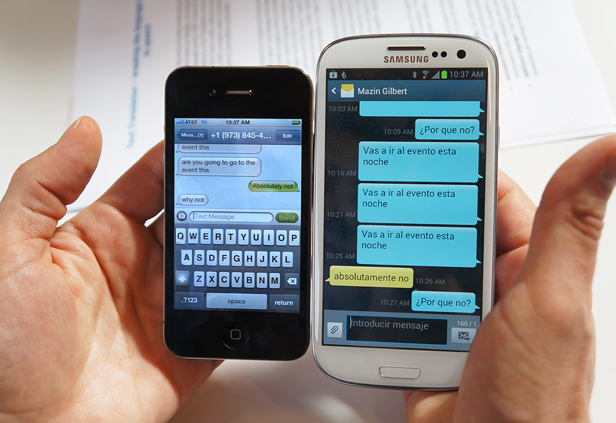AT&T Trials Text-Message Translation

Just because you can’t speak another language doesn’t mean you can’t text in it. Mobile network AT&T is trialing technology that lets customers send and receive text messages that are automatically translated from English to Spanish and back. A person simply registers a phone number as having a preferred language. Messages sent to that number in a different language are then automatically translated before being relayed to the person’s phone.
“If my friend sends me a message in Spanish, then AT&T recognizes the language and translates it to English,” says Mazin Gilbert, vice president for intelligent systems research at AT&T Labs in Florham Park, New Jersey. Gilbert helped develop the system. “Then I can send back in English, and it is translated into Spanish for her. We can go back and forth and have a conversation—we’re trying to break down language barriers between people.”
Gilbert demonstrated the system at the AT&T Foundry in Palo Alto, California, where AT&T collaborates with outside companies and researchers on new technology.
The current version of the technology only handles translation between English and Spanish, but AT&T has already deployed technology capable of handling six more languages in existing products, says Gilbert, so they could easily be added to the text message translation system.
Gilbert and his colleagues are rolling out a “working pilot” that will have AT&T employees try out the technology, which works on any cell phone and doesn’t require any software to be added to a handset.
“We envision this could be an extension to our SMS service to consumers,” says Gilbert. He thinks the service could be particularly attractive to families that include people who prefer speaking different languages, as well as businesspeople who work with contacts overseas.
One question the pilot is intended to answer is whether or how to signal to a person that a message they received has been translated, so they are aware they are not seeing the exact phrasing written in the original message. “The technology is not always perfect,” acknowledges Gilbert, and could introduce errors or confusing phrases to some messages.
Services that translate text are widely available online, and automatic language detection and translation is even built into Google’s e-mail service and instant messaging client. However, Gilbert says, AT&T is the first to demonstrate automatic translation of text messages in a way that doesn’t require a person to install additional software, or change from an existing service.
Earlier this year, AT&T showed a technology that allowed voice to be automatically translated between Spanish and English, without noticeable delay (see “AT&T Wants to Put Your Voice in Charge of Apps”). “That required a separate client that you download to your phone, like Skype,” says Gilbert. “We are now thinking about extending that so—like this text messaging technology—you don’t have to download anything.”
Keep Reading
Most Popular
Large language models can do jaw-dropping things. But nobody knows exactly why.
And that's a problem. Figuring it out is one of the biggest scientific puzzles of our time and a crucial step towards controlling more powerful future models.
The problem with plug-in hybrids? Their drivers.
Plug-in hybrids are often sold as a transition to EVs, but new data from Europe shows we’re still underestimating the emissions they produce.
Google DeepMind’s new generative model makes Super Mario–like games from scratch
Genie learns how to control games by watching hours and hours of video. It could help train next-gen robots too.
How scientists traced a mysterious covid case back to six toilets
When wastewater surveillance turns into a hunt for a single infected individual, the ethics get tricky.
Stay connected
Get the latest updates from
MIT Technology Review
Discover special offers, top stories, upcoming events, and more.